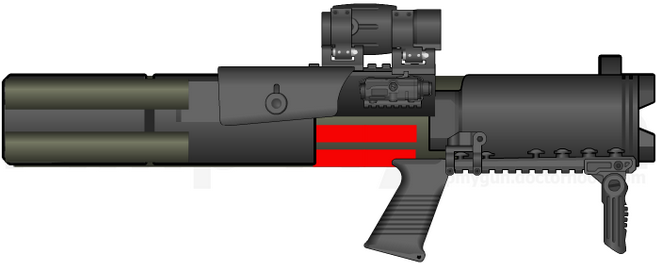MP-ATW
| MP-ATW | |
|---|---|
 | |
| Type | Anti-tank missile launcher |
| Place of origin | Astronea |
| Service history | |
| In service | 2010-present |
| Used by | Astronean Armed Forces |
| Production history | |
| Designer | Arlogh Ballistics |
| Designed | 2002 |
| Manufacturer | Talamnrath Precision Systems |
| Unit cost | $13,000 |
| Produced | 2009-present |
| Specifications | |
| Length | 1,006 mm (39.6 in) |
| Caliber | 150mm warhead |
| Muzzle velocity | 40 m/s to high subsonic 200 m/s (mach 0.7) |
| Effective firing range | 600 m (660 yd) |
| Maximum firing range | 1,000 m (1,100 yd) |
| References | |
The MP-ATW (Man-Portable Anti-Tank Weapon) is an advanced single use anti tank missile launcher. The "PAT" as it is commonly known, uses a top-down attack warhead, allowing it to defeat most modern armour threats, and due to soft launch technology, can safely be fired from enclosed spaces. Fiberglass materials keep the weight of the launcher at 12.5kg. The PAT produces no back blast, reducing the overall risk to operators and surrounding personnel.
Guidance is obtained using predicted line of sight (PLOS); for a moving target, the gunner maintains tracking for three seconds, training the missile's guidance electronics to compute the target's angular speed. After launch the missile flies autonomously to the target adjusting the necessary corrections according to the data acquired by the tracking.
The PAT was first introduced into Astronean service in 2009 and has since seen conflict, where it was commended for its ability to effectively engage all manner of armour threats with speed and precision. Its 150mm tandem warhead is capable of piercing 600mm of rolled homogeneous armour (RHA) after ERA, making it extremely effective against modern armour threats. MP-ATWs are used in both dedicated anti-tank teams and to augment standard infantry and weapons squads with advanced anti-armour capability beyond that of standard, smaller rocket launchers. It has seen success for export, gaining attention for its relatively low weight and effectiveness as an anti tank weapon.
Design
The missile is first launched out of the launcher using a low powered ignition. After the missile travels several meters into flight, its main rocket ignition occurs, which propels the missile from there on, to the target. Guidance is obtained using predicted line of sight (PLOS); for a moving target, the gunner maintains tracking for three seconds, training the missile's guidance electronics to compute the target's angular speed.
After launch the missile flies autonomously to the target adjusting the necessary corrections according to the data acquired by the tracking. It is unnecessary for the gunner to consider the range to the target. After launch the missile's position in its trajectory always coincides with the target irrespective of range.
The weapon's guidance system is located on a 2x magnified optic mounted adjacent to the launcher tube. A pistol and foregrip enable the weapon to be shouldered much like other comparable launchers, making its ergonomics both comfortable and familiar to the average infantry soldier. Once the weapon is shouldered, soldiers are trained to engage the guidance system via switch and calibration controls located next to the optic and laser module. From here, minimal adjustments can be made to distance, sensitivity, day/night and weather conditions.
Once ready, the targeting module will begin to track threats within visible range, painted by large green rectangle target markers. A single beep will emit from the system each second it begins tracking an individual target until it changes to emit a single prolonged tone, indicating the target is locked and the missile is ready to fire.
To fire the weapon, the operator disengages the safety lever using their index finger, which will engage a firing push button forward of the safety.
The targeting module optic has options for daytime mode, as well as an IR/NV infared and night vision mode for low light conditions.